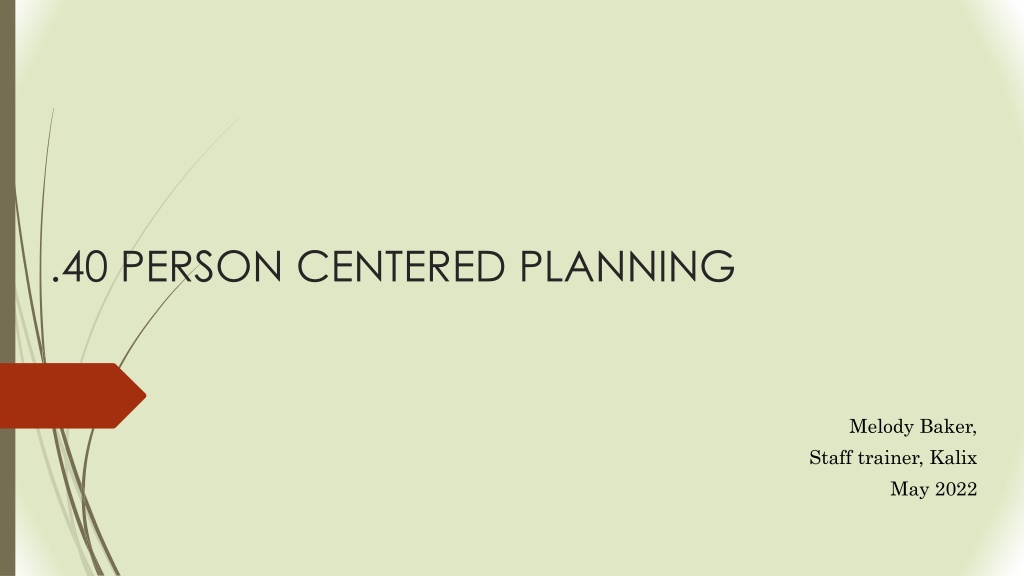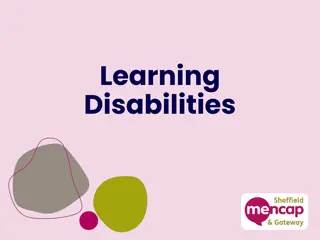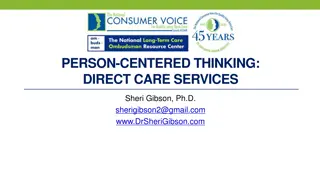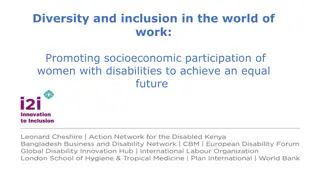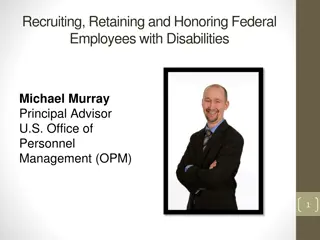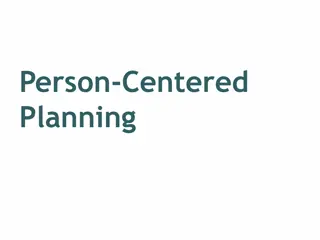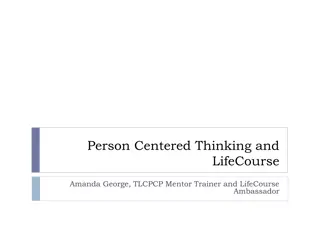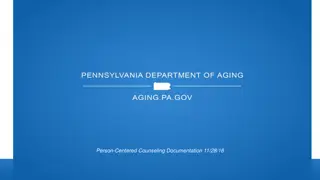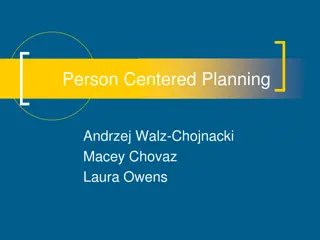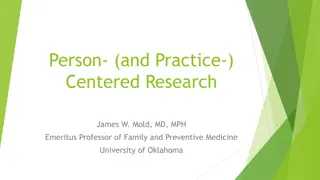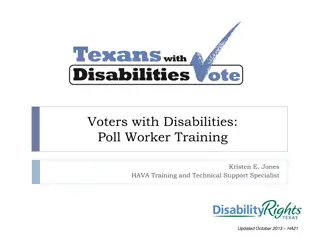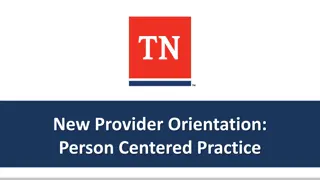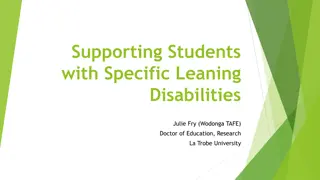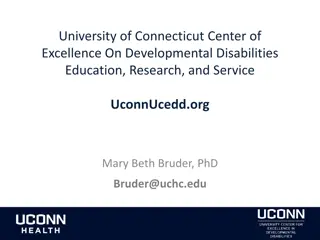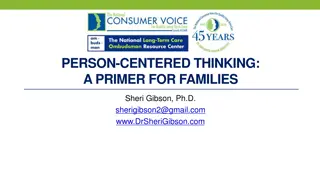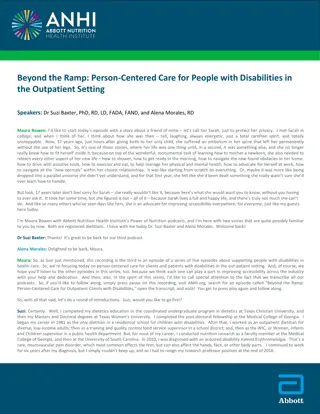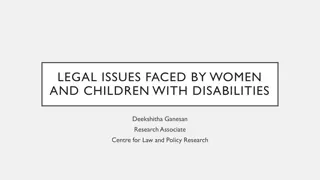Understanding Person-Centered Planning for Individuals with Disabilities
Person-centered planning is a vital ongoing problem-solving process aimed at enhancing the lives of individuals with disabilities by empowering them to plan for their futures. Through collaborative efforts, this approach focuses on developing personal relationships, gaining new skills, and fostering community participation to help individuals achieve their goals and increase control over their lives.
Download Presentation

Please find below an Image/Link to download the presentation.
The content on the website is provided AS IS for your information and personal use only. It may not be sold, licensed, or shared on other websites without obtaining consent from the author. Download presentation by click this link. If you encounter any issues during the download, it is possible that the publisher has removed the file from their server.
E N D
Presentation Transcript
.40 PERSON CENTERED PLANNING Melody Baker, Staff trainer, Kalix May 2022
Person Centered Planning is an ongoing problem-solving process used to help people with disabilities improve their lives and plan for their future. Person Centered Planning In person centered planning, groups of people who know an individual well, meet with the individual to help them plan how they can be actively involved in meaningful activities. They consider that person's preferences and ideas about what they would like to do in the future. This "person-centered" team meets to identify opportunities for the focus person to develop personal relationships that last, gain new experiences and skills, participate in their community, increase control over their own lives, and develop the skills and abilities needed to achieve these goals.
Person Centered Planning Discovery Process Person Centered Plan Employment Consensus Guardianship Team Planning Planning Meeting Active Support
The MOST important part of Person Centered planning is to build a meaningful life for the individual receiving services.
Working with people who know you well to set goals and working together to achieve those goals is a definition for team planning
Person centered planning is used: To meet accreditation requirements To share responsibilities Because people achieve more together than alone
Person Centered Plans Should contain ordinary language Tell about the person s preferences, goals and dreams and offer ways to provide support
Person Centered Plans Help discover a person s gifts and value in the community Help Evaluate Evaluate present situation Define changes Define
Person Centered Plans Assign specific staff to carry out plan Shows respect for the individual and their dreams The tool that is used to help keep teams accountable for what they agree to do
Person Centered Plans cannot promise that a goal will be achieved.
Consensus when the ENTIRE group decides to carry out the plan.
Background ______________ information: A record of important information about the person, their history and their life situation
Dreams, wishes, nightmares _____________________________ The vision for the kind of life that would have meaning for this person Strengths and needs ______________________________ The personal preferences and what others say about the person s accomplishments
__________ Notes on what was discussed or decided as a team Minutes
When there is a need to make a major change in a plan, the team should be called together as soon as possible Any major change must go through the person centered planning process. This includes a new job or a move to a new location.
After the Person-Centered Plan is developed, check to see if the plan is helping the person meet their goals
Team The names of the people who helped make the plan. members
Team Members: Person Guardian The person can invite whoever they want to their planning meeting Program Coordinator Family DSP/Support staff Employer Job coach DDPM (case manager)
DSPs are _____________ members of the team vital time They spend the most ______________ with the individual determine They can __________________ if the plan is being followed or if the plan is working They are the member of a team who know the person best.
The persons team may include: Psychologist Speech therapist minister Counselor Health care professional
Teams demonstrate respect for all members when they: Ask the person with a disability where they want their team to meet. Meet in a place where the person will be most comfortable. Select a time of day that works for everyone.
Before the meeting, DSPs are responsible to: Help the person get ready for the meeting Think about ways to overcome barriers and challenges to the person s goals Visit with the person about what is important to them Review the current plan
Strategies that increase the persons participation in a team meeting: They can set the date/time Bring ideas in a format the person can understand Use Active support Use visual aids (graph, pie chart, etc.) Put all the meeting steps into a PowerPoint and show the person how to advance each slide.
Strategies that increase the persons participation in a team meeting: Bring photosthat show some of this person s strengths and dreams for the future Look at photos of people who could attend. They can select pictures of people to invite. Record important decisions using clip art and key words.
Team Meeting Etiquette Dress properly (Follow the agency dress code) Listen, don t interrupt Share about the individual Be a role model Be prompt Prepare suggestions Bring a pen and a notepad Turn off your cell phone!
Preparing for a Meeting plan Know the ___________ person Know the ____________ Maintain professional appearance Be ready to share ___________ information positive Before a team meeting, the DSP should get to know the person and the person s plan well.
Direct support professionals assist the team in the Person Centered Planning process by: Sharing information at the meeting or with those who will attend the meeting Supporting the person to prepare for his or her meeting Regular documentation
Case Manager _________________(DDPM) Outside representative that ensures the individual is receiving necessary services
leader QDDP/PC - discussion ___________ voice Ensures everyone has a ___________ planning Assists the individual in ____________ the meeting Provides necessary information for everyone attending The most important role of the QDDP (Program Coordinator) at a team meeting is to lead the discussion and ensure that all team members have a voice.
The person or their family or guardians can share important ____________ with the team events This Photo by Unknown Author is licensed under CC BY-SA
important Friends or Co-workers have ________________ roles in the lives of individuals
The person or their residential staff would report on the progress at the person s apartment
The person or their psychologist would report on the results of an IQ test
The person or their job coach would suggest a new goal at work
The person or their Coordinator would share personal preferences and dreams
A person becomes legal age at age 18. The guardian of an individual receiving services is determined by courts and the individual s team. There are different types of guardians
Guardians and family members do not necessarily get all information about the individual unless permission is granted
Person Centered Planning plays a critical role in increasing employment for people with disabilities. The person-centered team provides individualized vocational support to each person.
Work should be presented as a high priorityacross the person s lifespan. People can achieve improved physical and mental health wages health, improved self wages through meaningful work self- -esteem esteem and
Employment Profile The Employment Profile includes the challenges the person has experienced This Photo by Unknown Author is licensed under CC BY
A benefit of integrated employment can be an increase in social connections.
A major barrier to increasing the number of people in integrated work settings is low expectations related to employment for people with disabilities.
Families may need information about career opportunities, and how work will impact impact the person s life A person s choices to pursue integrated employment is influenced by professionals and families.
Discovery The Discovery Processis a comprehensive planning support for people who need intensive individualized efforts to find a job.
The Discovery Process identifies: tasks the person could perform assistive technology needs Environmental supports Other support needs Personal preferences Contributions the person could make
